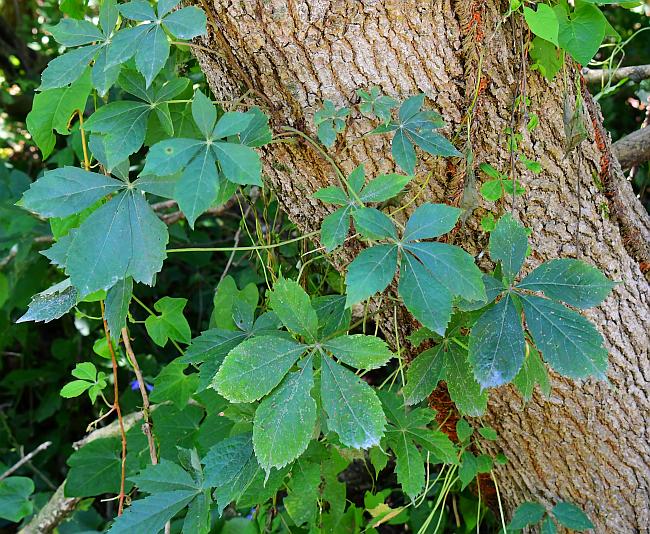Parthenocissus quinquefolia (L.) Planch.
Virginia Creeper

Native
CC = 3
CW = 3
MOC = 83
© SRTurner
Parthenocissus quinquefolia (L.) Planch.Virginia Creeper | |
 |
Native CC = 3 CW = 3 MOC = 83 |
© SRTurner |
|
Family - Vitaceae Habit - Lianas, climbing in trees or sometimes only scrambling on the ground.
Stems - Scrambling or climbing, to 30 m or more long, the older stems producing coarse aerial roots for anchors when climbing. Young stems glabrous or minutely hairy. Some nodes with tendrils, these with 5-8 branches, most of the tips with small circular adhesive discs.
Leaves - Alternate, long-petiolate, once palmately compound, usually with 5 leaflets. Leaflets 5-15 cm long, elliptic to obovate, tapered or narrowed at the base, tapered to a sharply pointed tip, the margins sharply toothed mostly above the midpoint, herbaceous or somewhat papery, not thickened, dull, glabrous, and dark green on the upper surface, paler, glabrous or hairy, and sometimes slightly glaucous on the undersurface.
Inflorescences - Opposite leaf bases, mostly longer than wide, usually with a zigzag central axis and the main branches repeatedly dichotomously forked, the 25-200 flowers in small umbellate clusters at the branch tips.
Flowers - Perfect or functionally staminate or pistillate, hypogynous, actinomorphic. Calyces fused into a low spreading collar, this sometimes shallowly 4-or 5-lobed. Corollas of mostly 4 or 5 free yellowish-green petals. Stamens mostly 4 or 5 (produced but somewhat reduced and nonfunctional in pistillate flowers), opposite the petals, the anthers minute, attached near their midpoint. Nectar disc present, reduced and fused to the ovary. Pistil 1 per flower (reduced and nonfunctional in staminate flowers), of usually 2 fused carpels. Ovary superior (but sometimes appearing somewhat sunken into the nectar disc), 2-locular, each locule with 2 ovules, the placentation more or less basal. Style 1, the stigma minute, unlobed or slightly 2-lobed.
Fruits - Globose berries 5-8 mm in diameter, with 1-4 seeds, these 3.5-4.0 mm long, the surface smooth to finely wrinkled, shiny, brown to dark brown.
Flowering - May - August. Habitat - Bottomland and mesic forests, bluffs, streambanks, fencerows, fields, pastures, roadsides, railroads, shaded disturbed areas. Origin - Native to the U.S. Lookalikes - Parthenocissus vitacea. Distantly, Toxicodendron radicans. Other info. - This familiar species is common across all of Missouri, as well as most of the eastern half of the continental U.S. It is easily recognized by its vining habit and palmately compound leaves which typically have five leaflets. Although Toxicodendron radicans (poison ivy) is listed as a lookalike, the two actually look very little alike except that both are commonly found vining on trees. Some of the confusion might arise from the insidious habit of poison ivy to conceal itself within lush growths of Virginica creeper, accounting for many cases of inadvertent exposure and possibly leading to the impression that the five-leafed plant was the cause of an itchy rash! A much closer lookalike is P. vitacea, which has very similar leaves but inflorescences which are more broadly branched. That plant also lacks the adhesive disks on the tendrils. P. vitacea is rare in Missouri. Photographs taken at Busch Greenway / Duckett Creek, St. Charles County, MO, 6-29-2015, along the Katy Trail near Treloar, Warren County, MO, 7-16-2020, near Labadie, Franklin County, MO, 7-17-2020 and 7-2-2025, along the Katy Trail near Marthasville, Warren County, MO, 6-5-2022, and along the Katy Trail near Dutzow, Warren County, MO, 9-21-2023 (SRTurner). |